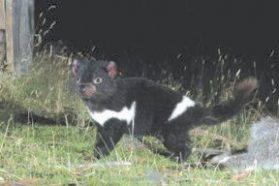Poor Devils
When Tasmanian devils bite each other, they may pass on a fatal disease.
By Emily Sohn
The real Tasmanian devil doesn’t look much like the familiar snarling and whirling cartoon character known as Taz, but it’s every bit as fierce.
When European settlers arrived on the Australian island of Tasmania and met the small marsupial, they called it a “devil” for its furious temper, loud screeches, and bad behavior.
 |
|
Tasmanian devils are marsupials, which means that, like kangaroos, opossums, wombats and koalas, they are pouched mammals. |
| C. Baars |
Devils fight most often over food and mates, often biting each other on the face. But this biting habit could have deadly consequences. During biting, devils may be spreading a deadly disease.
The illness, known as devil facial tumor disease, produces open wounds on a devil’s mouth, which soon spread and become large tumors on its face and neck. A tumor is an abnormal growth in the body caused by cells that multiply without stopping.
Once the wounds appear, many devils die of starvation within 6 months because the resulting tumors can keep the devils from eating.
The first sick animal appeared in the 1990s, and the disease, a kind of cancer, has now spread to animals across half the island.
To find out what was causing the disease, researchers studied cells in the devils’ tumors. They discovered that these cancerous cells were quite different from the animals’ healthy cells. But the tumor cells were identical in different animals.
This finding suggested that cancerous cells were spreading directly from animal to animal, from bite wound to bite wound.
Devils are protected in Tasmania as a national symbol, but this disease is already hurting the population. The animals don’t exist anywhere else in the world, and researchers are afraid they’ll go the way of the extinct Tasmanian tiger.
But the good news is that, if the disease is spread only through bites, keeping infected animals away from healthy populations might be enough to save them. Tasmanian wildlife biologists are already trying this out, and they say it just might be working.—C. Gramling
Going Deeper:
Gramling, Carolyn. 2006. Poor devils: Critters’ fights transmit cancer. Science News 169(Feb. 4):67. Available at http://www.sciencenews.org/articles/20060204/fob1.asp .
You can learn more about the Tasmanian devil at www.dpiwe.tas.gov.au/inter.nsf/WebPages/BHAN-5358KH?open (Department of Primary Industries, Water & Environment, Tasmania) and www.parks.tas.gov.au/wildlife/mammals/devil.html (Parks and Wildlife Service, Tasmania).
For information about marsupials, go to www.ucmp.berkeley.edu/mammal/marsupial/marsupial.html (Museum of Paleontology, University of California, Berkeley).







